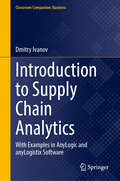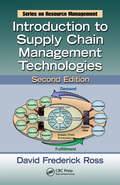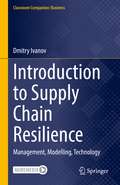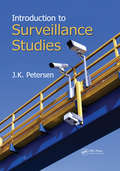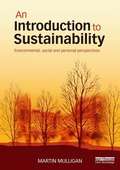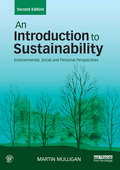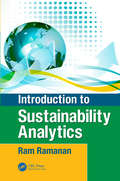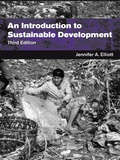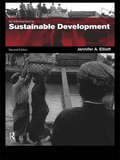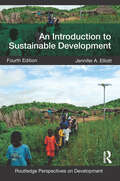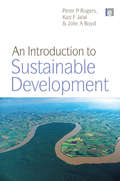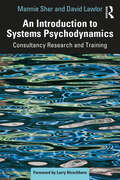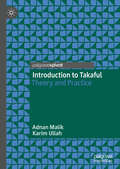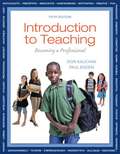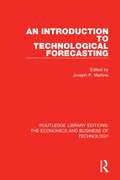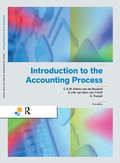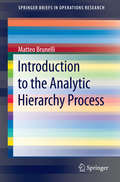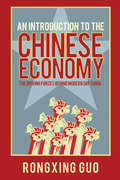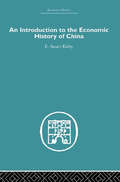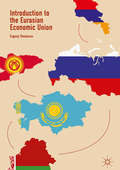- Table View
- List View
Introduction to Strategic Innovation
by Vijay Govindarajan Chris TrimbleIn today's marketplace, characterized by rapid and nonlinear change, executing strategic innovation successfully has become imperative for generating sustained growth and extending the corporate life span. In this chapter, the authors describe and demystify strategic innovation.
Introduction to Supply Chain Analytics: With Examples in AnyLogic and anyLogistix Software (Classroom Companion: Business)
by Dmitry IvanovThe book offers a concise yet comprehensive introduction to supply chain analytics covering management, modeling, and technology perspectives. Designed to accompany the textbook “Global Supply Chain and Operations Management”, it addresses the topics of supply chain analytics in more depth. The book describes descriptive, predictive, and prescriptive supply chain analytics explaining methodologies, illustrating method applications with the use of training exercises, and providing numerous examples in AnyLogic and anyLogistix software. Throughout the book, numerous practical examples and short case studies are given to illustrate theoretical concepts. Along with AnyLogic and anyLogistix model development guidelines and examples, the book has two other distinct features. First, it reviews and explains novel frameworks and concepts related to data-driven decision-making and digital twins. Second, it shows how to use analytics to improve supply chain resilience.Without relying heavily on mathematical derivations, the book offers a structured presentation and explanation of major supply chain analytics techniques and principles in a simple, predictable format to make it easy to understand for students and professionals with both management and engineering backgrounds. Graduate/Ph.D. students and supply chain professionals alike would benefit from a structured and didactically-oriented concise presentation of the concepts, principles, and methods of supply chain analytics. Providing graduate students and supply chain managers with working knowledge of basic and advanced supply chain analytics, this book contributes to improving knowledge-awareness of decision-making in increasingly data-driven and digital environments. The book is supplemented by a companion website offering interactive exercises with the use of AnyLogic and anyLogistix software as well as Spreadsheet Modeling.
Introduction to Supply Chain Management Technologies (Resource Management)
by David Frederick Ross Frederick S. Weston Stephen W.It is almost impossible to conceive of the concept and practical application of supply chain management (SCM) without linking it to the enabling power of today‘s information technologies. Building upon the foundations of the first edition, Introduction to Supply Chain Management Technologies, Second Edition details the software toolsets and suites
Introduction to Supply Chain Resilience: Management, Modelling, Technology (Classroom Companion: Business)
by Dmitry IvanovThis book offers a concise yet comprehensive introduction to supply chain resilience, covering management, modeling and technology perspectives. Designed to accompany the textbook “Global Supply Chain and Operations Management” it addresses the topics of supply chain risks and resilience in more depth, describing the major features of supply chain resilience and explaining methodologies to mitigate supply chain disruptions and recover. Numerous practical examples and short case studies are provided to illustrate theoretical concepts. Without relying heavily on mathematical derivations, the book explains major concepts and methods to build and improve supply chain resilience and tackle supply chain disruption risks in a simple, uniform format to make it easy to understand for students and professionals with both management and engineering backgrounds. Graduate/PhD students and supply chain professionals alike will benefit from the structured, didactically oriented and concise presentation of the concepts, principles and methods of supply chain resilience management, modeling, and technological implementation.
Introduction to Surveillance Studies
by J.K. PetersenSurveillance is a divisive issue one might say it is inherently controversial. Used by private industry, law enforcement, and for national security, it can be a potent tool for protecting resources and assets. It can also be extremely invasive, calling into question our basic rights to freedom and privacy. Introduction to Surveillance Studies explo
An Introduction to Sustainability: Environmental, Social and Personal Perspectives
by Martin MulliganAn Introduction to Sustainability provides students with a comprehensive overview of the key concepts and ideas which are encompassed within the growing field of sustainability. The book teases out the diverse but intersecting domains of sustainability and emphasises strategies for action. Aimed at those studying the subject for the first time, it is unique in giving students from different disciplinary backgrounds a coherent framework and set of core principles for applying broad sustainability principles within their personal and professional lives. These include: working to improve equality within and across generations, moving from consumerism to quality of life goals and respecting diversity in both nature and culture. Areas of emerging importance such as the economics of happiness and wellbeing stand alongside core topics including: Energy and society Consumption and consumerism Risk and resilience Waste, water and land. Key challenges and applications are explored through international case studies and each chapter includes a thematic essay drawing on diverse literature to provide an integrated introduction to fundamental issues. Launched with the brand-new Routledge Sustainability Hub, the book's companion website contains a range of features to engage students with the interdisciplinary nature of Sustainability. Together these resources provide a wealth of material for learning, teaching and researching the topic of sustainability. This textbook is an essential companion to any sustainability course.
An Introduction to Sustainability: Environmental, Social and Personal Perspectives
by Martin MulliganAn Introduction to Sustainability provides students with a comprehensive overview of the key concepts and ideas which are encompassed within the growing field of sustainability. The fully updated second edition, including new figures and images, teases out the diverse but intersecting domains of sustainability and emphasises strategies for action. Aimed at those studying the subject for the first time, it is unique in giving students from different disciplinary backgrounds a coherent framework and set of core principles for applying broad sustainability principles within their own personal and professional lives. These include: working to improve equality within and across generations; moving from consumerism to quality of life goals; and respecting diversity in both nature and culture. Areas of emerging importance such as the economics of prosperity and wellbeing stand alongside core topics including: · Energy and society · Consumption and consumerism · Risk and resilience · Waste, water and land. Key challenges and applications are explored through international case studies, and each chapter includes a thematic essay drawing on diverse literature to provide an integrated introduction to fundamental issues. Housed on the Routledge Sustainability Hub, the book’s companion website contains a range of features to engage students with the interdisciplinary nature of sustainability. Together these resources provide a wealth of material for learning, teaching and researching the topic of sustainability. This textbook is an essential companion to any sustainability course.
Introduction to Sustainability: Road to a Better Future
by Nolberto MunierThis book develops a supporting structure for sustainable development, following a natural set of steps to reach an established goal. It provides the tools to navigate this Road to a Better Future by explaining concepts, giving ideas, proposing methods, and suggesting actions. To illustrate the utilization of techniques there are many examples, applied to a variety of activities, and to wrap up concepts, the last chapter is dedicated to the analysis of a community in search of a sustainable environment. A thematic index has been designed to help a person quickly find information on relevant topics.
Introduction to Sustainability Analytics
by Raghavan Ram RamananThe roles of corporate and public stewards and the nature of their social contract with society have been changing over the past two centuries, and those changes have accelerated in recent decades. Moreover, with increasing focus on sustainability factors from the marketplace (regulators, investors, financiers, and consumers), corporate sustainability disclosure is shifting from voluntary to vital. Corporate and public stewards are now responsible for their performance and services from cradle-to-grave: they must properly manage corporate social responsibility and integrate it into their global strategies, rather than consider it as merely a moral obligation or a risk/reputation management exercise. <P><P> Sustainability analytics, the critical link between sustainability and business strategy, helps professionals track, trend, and transform sustainability information into actionable insights across the value chain and life cycle, to enhance their sustainability performance and its disclosure. This book, Introduction to Sustainability Analytics, provides corporate and public stewards with a comprehensive understanding of how to determine which sustainability metrics are material to them and relevant to their business, and how to incorporate them into corporate strategy, resource allocation, and prioritization. Focusing on practical decision-making needs, it explains how to value and prioritize initiatives, and how to best allocate necessary resources through several real case studies and practical examples. <P><P> Features: <P><P> Examines pressing issues such as climate change, water scarcity, and environmental justice <P><P> Explains how to develop a business case and global strategy for social responsibility <P><P> Includes both corporate and public policy perspectives on sustainability economics <P><P> Covers emerging regulations on sustainability disclosure and responsible investing
An Introduction to Sustainable Aquaculture
by Daniel Peñalosa Martinell Vergara-Solana, Francisco J Araneda Padilla, Marcelo E Fernando Aranceta GarzaThis new textbook provides an accessible introduction to sustainable aquaculture through its relationship with three key pillars: the environment, the economy, and society.As the demand for seafood keeps increasing, aquaculture is considered one of the most promising and sustainable ways to satisfy this demand with nutritious and high-quality food. It is important to understand, therefore, the wider role and impact aquaculture has on the environment, the economy, and society. The book begins by providing a foundational introduction to aquaculture and sustainability, discussing the complex and interdependent relationship that exists between the two. The core text of the book is divided into four parts which focus on the environment, economics, social impacts, and governance and technologies. Chapters examine key issues surrounding climate change, food security, new technologies, bioeconomics and risk analysis, international cooperation, employment, and animal welfare, with the book concluding with a chapter examining the future directions and challenges for the aquaculture industry. The book draws on global case studies and each chapter is accompanied by recommended reading and chapter review questions to support student learning.This book will serve as an essential guide for students of aquaculture, fisheries management, and sustainable food, as well as practitioners and policymakers engaged in sustainable fishery development.
An Introduction to Sustainable Development
by Jennifer ElliottThis third edition of a successful, established text provides a concise and well-illustrated introduction to the ideas behind, and the practices flowing from the notion of sustainable development.
An Introduction to Sustainable Development
by Jennifer ElliottThis third edition of a successful, established text provides a concise and well-illustrated introduction to the ideas behind, and the practices flowing from the notion of sustainable development.
An Introduction to Sustainable Development (Routledge Perspectives on Development)
by Jennifer ElliottThis fourth edition has been comprehensively rewritten and updated to provide a concise, well illustrated and accessible introduction to the characteristics, challenges and opportunities of sustainable development with particular reference to developing countries. The contested nature of sustainable development is explored through a detailed consideration of changing ideas and practices within environmentalism and development thinking. The text identifies the different actors involved (from institutions of global governance through to community based organisations), the policies and mechanisms through which sustainable development is being sought and considers the outcomes for particular groups and environments in both rural and urban contexts. ?? This edition places stronger emphasis on the global challenges of sustainable development with an understanding of inter-linked crises in climate, energy, economy, poverty and social injustice. It explores how these issues are leading to deep questioning of what sustainable development is, what it should be, and how sustainable development policies and mechanisms are being reconsidered. The book gives new consideration to the challenge of achieving lower carbon growth, climate adaptation, and the implications on sustainable development of rapidly expanding economies, including China and India. It contains greater discussion of how civil society movements influence outcomes of international climate policy, as well as technological developments in energy and agriculture. The text also contains a substantially expanded discussion of how poverty remains central to sustainable development challenges, as revealed through the Millennium Ecosystem Assessment and Millennium Development Goals. This invaluable text retains the core message that sustainable development has become central to debates about environment and development. Containing a substantial number of new boxed case studies, learning outcomes, chapter summaries, discussion questions, further reading and websites, this text provides an essential introduction for students.
An Introduction to Sustainable Development
by Peter P. Rogers Kazi F. Jalal John A. BoydThis volume is the most comprehensive textbook on sustainable development. It has been developed with students and professionals from around the world specifically for those who need a thorough grounding in the subject. Coverage includes: background to sustainable development and global environmental issues; measurement and sustainability indicators; environmental assessment, management and policy; approaches and linkages to poverty reduction; impacts and infrastructure development; economics, consumption, production and market failures; governance; participation; disaster management; international financial institutions; international environmental agreements; and the role of civil society.
An Introduction to Systems Psychodynamics: Consultancy Research and Training
by Mannie Sher David LawlorThis book provides an introduction to systems psychodynamic theory and its application to organisational consultancy, research and training, outlining systems dynamics methods and their historical and theoretical developments. Systems Psychodynamics is an emerging field of social science, the boundaries of which are continually being refined and re-defined. The ‘systems’ designation refers to open systems concepts that provide the framing perspective for understanding the structural aspects of organisational systems. These include its design, division of labour, levels of authority, and reporting relationships; the nature of work tasks, processes, and activities; its mission and primary task; and the nature and patterning of the organisation’s task and sentient boundaries and the transactions across them. This book presents a critical appraisal of the systems psychodynamics paradigm and its application to present-day social and organisational difficulties, showing how a holistic approach to organisational and social problems can offer a fresh perspective on difficult issues. Bringing together the theory and practice of systems psychodynamics for the first time, this book provides an examination of the systems psychodynamics paradigm in action. This book gives an accessible and thorough guide to understanding and using systems psychodynamic ideas for analysts, managers, policy makers, consultants and researchers in a wide range of professional and clinical settings.
Introduction to Takaful: Theory and Practice
by Adnan Malik Karim UllahThis book provides a comprehensive account of the theory and practice of takaful, which is an Islamic alternative to insurance. The concepts are explained using real-life case studies, calculations, and exhibits to aid in reader learning and reflection. Takaful, both as an academic subject and as well as practice, is growing particularly in the world leading financial and learning hubs such as in the UK and the USA and countries with large Muslim populations in Asia, Africa, and Middle East.
Introduction to Teaching: Becoming a Professional (Fifth Edition)
by Don Kauchak Paul EggenThe best-selling case-based text, Introduction to Teaching: Becoming a Professional, sharpens its focus on issues in education in its Fifth Edition. Weaving this focus throughout every chapter with new features and chapter sections covering diversity, reform, urban education, and technology, the text ensures that prospective teachers gather all the needed information to create an up-to-date picture of the ever changing face of education. The authors take this information and bring it to life with cases, classroom examples and videos, again ensuring that the living, changing, challenging and fulfilling life of an educator is as clear as it can be.
An Introduction to Technological Forecasting (Routledge Library Editions: The Economics and Business of Technology #31)
by Joseph P. MartinoOriginally published in 1972 this book examines technological forecasting and assesses its merits and limitations and possible uses for society, government, industry and the military. Although technological forecasting was in its infancy when this book was originally published, it has now become part of mainstream social and economic planning.
Introduction to the Accounting Process
by C.A.M. Klerks-van de Nouland H.J.M van Sten-van 't HoffIntroduction to the Accounting Process brings clarity to to the process of setting up an accounting system, including a basic explanation of how to enter numbers into the system manually. The clear structure of the book provides students with good insight into the basics of accounting. The book consists of four parts: designing an accounting system special entries and frequently occurring themes such as VAT, clearing of invoices and discounts international aspects of accounting, including ratio analysis an integrated case enabling students to show their knowledge in practice The simple structure and concise nature of the book, combined with a useful companion website, will help students to improve on any deficiencies in the subject.
Introduction to the Analytic Hierarchy Process
by Matteo BrunelliThe Analytic Hierarchy Process (AHP) has been one of the foremost mathematical methods for decision making with multiple criteria and has been widely studied in the operations research literature as well as applied to solve countless real-world problems. This book is meant to introduce and strengthen the readers' knowledge of the AHP, no matter how familiar they may be with the topic. This book provides a concise, yet self-contained, introduction to the AHP that uses a novel and more pedagogical approach. It begins with an introduction to the principles of the AHP, covering the critical points of the method, as well as some of its applications. Next, the book explores further aspects of the method, including the derivation of the priority vector, the estimation of inconsistency, and the use of AHP for group decisions. Each of these is introduced by relaxing initial assumptions. Furthermore, this booklet covers extensions of AHP, which are typically neglected in elementary expositions of the methods. Such extensions concern different numerical representations of preferences and the interval and fuzzy representations of preferences to account for uncertainty. During the whole exposition, an eye is kept on the most recent developments of the method.
An Introduction to the Business of Tourism
by Venu Vasudevan B. VijayakumarThis textbook offers a lucid understanding of the business of tourism and helps students gain professional and entrepreneurial insights. An outcome of years of experience and practice, An Introduction to the Business of Tourism offers a fresh perspective of the skill-oriented, knowledge-based and multi-disciplinary arena of the tourism business. It presents a balanced mix of the basic principles and concepts, their application and policy implications as well as the business realities and operational aspects of the tourism industry. Divided into four sections and spread across nineteen chapters, this textbook delves deep into Indian and international tourism experiences with numerous integrated case studies and examples. Key Features: Special emphasis on recent business aspects of tourism from local and global perspectives Over 45 case studies to provide valuable insights into current business trends to strengthen the practical knowledge of students Each chapter has review questions and activities to support self-assessment. Book-end glossary of major concepts and terminologies to facilitate quick scan and easy understanding
Introduction to the Case Method
by Benson P. ShapiroGuidelines to aid the student in analyzing a case situation by casting himself or herself in the role of protagonist, developing criteria for alternative decisions, and generalizing to other situations.
An Introduction to the Chinese Economy: The Driving Forces Behind Modern Day China
by Rongxing GuoThis comprehensive overview of the modern Chinese economy by a noted expert from China offers a quality and breadth of coverage. In this book, the author provides an introduction to China's economy since 1949 and original insights based on his own extensive research. The book sets out to analyze and compare the operational mechanisms of the Chinese economy between the pre- and post-reform periods and through national, regional and local dimensions. Both positive and negative consequences of the Chinese economic transformation have been clarified. A multiregional comparison of the Chinese economy is conducted in terms of natural and human resources, institutional evolution, as well as economic and social performances. At last, some key issues relating to the inherent operational mechanisms of and the dynamic patterns of the Chinese economy are also discussed.
Introduction to the Economic History of China
by Stuart KirbyFirst Published in 2005. Routledge is an imprint of Taylor & Francis, an informa company.
Introduction to the Eurasian Economic Union
by Evgeny VinokurovThe Eurasian Economic Union (EAEU), which includes Russia, Kazakhstan, Belarus, Kyrgyzstan, and Armenia, is a new but substantial regional organization. Significant achievements include a common external customs tariff, a customs union and a common labour market: a well-developed institutional environment has emerged to support and advance these processes, ranging from the Eurasian Economic Commission and the EAEU Court to the Eurasian Development Bank and the Eurasian Fund for Stabilization and Development. This major integration achievement also has several drawbacks and ‘stumbling stones’—some due to Russia’s dominant position, some due to the authoritarian nature of political regimes, and some due to dependence on oil and gas exports. This book presents a detailed qualitative and quantitative assessment of the Eurasian Economic Union, including the history of Eurasian integration, the macroeconomy of EAEU member states, an assessment of trade and investment links, a descriptive analysis of the EAEU Treaty, an analysis of Eurasian institutions, the sociology of integration, the EAEU’s emerging foreign economic policy, relations with the EU and China, the EAEU’s position on One Belt One Road policies, and its mid-term policy agenda. This primer text will be of interest and value for students, academics and practitioners working in economic policy and business communities and interested in the history and development of the Eurasian Economic Union.

